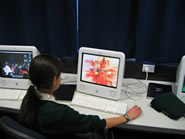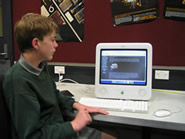
Case Study BP628: A Junior ICT Programme
Abstract

Reference: Case Study BP628
Classroom Practice: Year 10
Title: A Junior ICT Programme
Overview:
Teachers Steve Graham and Malcolm Howard were challenged to design a Year 10 ICT course that would introduce students to the philosophy and skills of Technological Practice and at the same time engage and absorb them, nurture their creativity, and encourage them to go on to study technology/ICT at a senior level.
Focus Points:
Background

Katikati College in the Bay of Plenty is a decile 6 co-educational Year 7-13 school with a role of about 950 students. In Years 7-9, students follow through a broad technology programme covering ICT, Materials Technology and Food Technology. ICT becomes a full-year option in Year 10 together with Materials Technology (metal, wood and fabric), Food Technology and Graphics.
Teacher Steve Graham qualified and worked as an economist in New Zealand and overseas before returning to New Zealand in the late 1980's to buy an orchard in Katikati and convert it into an organic-certified operation. During these years Steve also attended his local Polytech to continue upskilling in computing, a process that began while he was working overseas. In 1997 he qualified as a teacher and began teaching ICT and Economics at Katikati College. The Technology Faculty at the college is headed by Malcolm Howard.
Steve and Malcolm have participated in a Beacon Practice project for two years, which involves getting together with technology teachers from Hillcrest High School, Hamilton, to share ideas about advancing their teaching practices. As part of this project, Steve and Malcolm worked with Beacon Practice Professional Support Facilitators Hugh Derham and Cliff Harwood. Hugh's role was mainly to advise on the appropriate ICT content for courses as well as providing guidance on ways of creating opportunities for students to be creative in their tech practice and finding better ways of collecting evidence of student's tech practice. Cliff's role was to ensure teaching and learning at the school reflected current best practice in technology education.
Steve and Malcolm wanted to incorporate these strategies into the 2006 Year 10 ICT course.
Pre-planning

The 2006 Year 10 ICT course didn't come out of nowhere, Steve says, but is the result of several years of evolutionary progress. "It hasn't been a case of wiping the slate clean and starting with a new course this year. We've been developing these units for the last three or four years. So what we've got now is the 2006 version."
The 2006 Year 10 ICT option was structured into four one-term modules. Each unit of work had a clearly defined set of learning outcomes. The focus of each unit was on: developing progression in one of the three components of technological practice; developing progression in the ICT domain knowledge and skills needed for Year 11; and developing a broad literacy of ICT issues.
The overall aim of the course was to equip students with a combination of ICT and Technological Practice skills and knowledge that would allow them to move into the achievement standards-based senior programmes with confidence.
"We wanted the students to have enjoyed their year and to come out enthusiastic and well prepared for our senior ICT courses. The enjoyment factor was critical in the way we designed the course - all the skills in the world are no use to us, if the students aren't opting in to senior courses."
Using their established units as a foundation and a framework, Steve and Malcolm set about refining them into something that offered progression and would serve as a base for the senior level in ICT and technological practice skills/ knowledge and allow for some experimentation with the two new strands of the technology curriculum - Technological Knowledge and The Nature of Technology.
"Just as we teach blocks of skills, so we teach blocks of technological practice based on the Components of Practice."
Another focus of the course was the development of creativity. Under the auspices of a Beacon Practice project, Steve and Malcolm worked with Beacon Practice Professional Support Facilitator Hugh Derham to create opportunities for students to be creative in their technological practice. One strategy worked into the course design was to encourage the greater use of visual diaries. Another put teenage narcissism into harness by giving the course a teenage focus and having students aim all their products at people their own age.
Delivery

Screenshot from Paul's worms presentation
In the first three one-term units, students worked on individual projects, in which students learnt to use a variety of software packages, learnt about typography and design principles and how to use a visual diary to design and to develop concept ideas. In term four, the students formed into groups and worked together on a more loosely-defined collaborative project.
Steve and Malcolm gradually exposed students to the three components of technological practice thereby creating the working context for the projects and shaped the way students approached them. The first term focussed on 'Planning for Practice' and 'Outcome Development and Evaluation', the second focussed on 'Brief Development'.
The first project, in term one, was to design and produce the label and cover documentation for a backup CD Rom which eventually contained all of the work each student created during the year. Students learnt Freehand, a vector drawing programme, and the principles of typography and print design, which enabled them to produce high quality printed material.

The student instructions (pdf 204Kb) for this first unit were fairly explicit, Steve says. This was because the first term's project was quite guided while subsequent projects became less guided -all part of the theme of progression.
In the second unit of work (pdf 64Kb), students were taught how to create a kiosk PowerPoint presentation. After choosing a topical ICT issue (viruses, spam, e-crime, etc), and researching it, students created a PowerPoint presentation about their topic. In creating their screen presentation, students applied the design and typography concepts learnt in the previous unit. They also learnt how to manipulate digital images using Fireworks to enhance their presentation through the use of animations and text effects.
Steve says dealing with topical ICT issues like spamming and viruses allowed for experimentation with "Nature of Technology" material.

Screenshot from Ashley's website
During the third term, attention turned to web design (pdf 272Kb). Students were introduced to the web publishing program Dreamweaver through a series of teacher demonstrations and student worksheets. They also learnt how to use its associated image processing program Fireworks to create animated gifs for the web. Students built on their knowledge of typography and design, acquired in the first two units of work, by studying website planning and design. This led into the project for the term - the creation of a website detailing the development of the computer and its two-way interaction with society.
By exploring the impact computers have on modern life and the impact that events such as World War 2 and the 'Space Race' had on the development of the computer, the topic introduces the 'Nature of Technology' strand into the programme.
Students were given much less guidance in the term three project than they were in term one, Steve says.
"This is where one aspect of the progression comes in, as students have to have a deeper understanding of the particular component in order to be able to integrate it into their practice without teacher guidance."
The final term began with a burst of short exercises on creativity; then, after tuition in the use of Mac movie editing software iMovie and iDVD, the class moved into groups to focus on the final 'Digital Creativity' project.

In teaching terms, the aim of unit four was to "consolidate the technological practice, domain knowledge and skills base developed over the first three terms." In simpler terms, the aim was to have students cut loose with everything they had learnt in the year and really show it off.
In designing and delivering the programme, Steve and Malcolm had to be mindful of their assessment obligations, and so methods of assessing how students were grasping the three Components of Practice were carefully integrated into the year's programme. In term one, assessment focussed on the 'Planning for Practice' and 'Outcome Development and Evaluation' Components of Practice. From term two 'Brief Development' was assessed as well. Assessment criteria were based on Level Five of the Technology Curriculum.
Outcomes
The excellent standard of the student outcomes for the year are testament to the successful implementation of the four major areas of strategic focus set by the cluster group (see Case Study BP604) – students were learning a wide range of new ICT skills and knowledge within a technology framework, while having fun and being highly creative.
Term 1 CD Covers project
Ethan Luke Matthew Monica Sven
Click images for larger versions of the CD labels and their booklets.
Term 2 Powerpoint presentations project
Ashley (.ppt, 2.7Mb) Ethan (.ppt, 2.4Mb) Luke (.ppt, 2.8Mb)
Michael (.ppt, 4Mb) Monica (.ppt, 6.2Mb) Paul (.ppt, 3.7Mb)
Note that these large files are not designed for use as web-based media.
Term 3 Website project
Ashley's Website Michael's Website Monica's Website
Steve is pleased with the structure of the course and the learning progression it delivered. "As well as a progression in skills and tech practice, there's also progression in the ICT knowledge with typography and design skills introduced in the print project in term one then we go back and revisit design principles that are more relevant to a solution on screen as opposed to a solution in print...so there's a progression there. And again in term three we look at good design principles in terms of a website."
Steve believes the quality of the student outcomes in all four units reflects not only the emphasis placed of skill, tech practice, and knowledge development but also the time put into encouraging student creativity.
He says some of the students were very creative in the way they approached their work. As an example he cites a Paul's PowerPoint presentation Worms (above), which starts with an animation of a battle scene in which a group of worms take over control of the inside of a computer.
Malcolm Howard believes having students produce material for their own demographic helps foster this creativity. "What we've been pushing is that they're producing material for a teenage target audience, and with that specific focus they've been doing way more creative things this year."
And so do the students. "I've enjoyed thinking of creative ideas... putting my mind to it and thinking what would attract the attention of the stakeholders," says Monica, whose visual diary is featured on the right menu.
One of the most noticeable outcomes of the course design, Steve says, was the obvious enjoyment and engagement of students (of all abilities) throughout the year. "I could see that the students enjoyed the course a lot more. They liked the variety in the project work and the higher creative element in it."
The manner in which students responded to working in groups in their final project delighted both Steve and Malcolm and encouraged them to consider embedding this unit into the programme. In term four, when students worked in groups it was clear the students were reinforcing earlier learning by teaching each other skills that may have slipped-by them earlier.
Group work was popular with the students. Student feedback included comments such as: "I like the new idea of working in teams..."; "Working in a team is much better because you can think of ideas together and its more interesting and fun..."; and "It's not so much like hard work because when you're working as an individual it takes a lot of time, whereas if everyone is doing a bit then its all much faster...."
Steve suggests the structured approach to the teaching of technological practice through a focus on specific components of practice within each unit gave students a familiarity with the process. This will ease the transition from Year 10 ICT into the Year 11 NCEA ICT course, he says, and he is confident the course provided a sound base for the students to build on as they move into the range of senior ICT programmes the school offers.
The success of the course, Steve says, can be judged by the number of students who opted to carry on with ICT into the senior school and the number of students opting for Year 10 ICT. "The students this year have been very highly motivated and we can see this in the high numbers coming through into Year 11 in 2007 and the quality of students who have opted in."
What next?

Malcolm Howard thinks the Year 10 course is "pretty close" to being right.
"In the past we've made some pretty major changes to some of the units, but now it's just a case of on-going refinement. A focus in 2007 will be building on the experience gained through experimentation with incorporating the 'Nature of Technology' and 'Technological Knowledge' strands of the Draft Curriculum Statement for Technology into the Year 10 programme." In 2007 first term will focus on 'Planning for Practice' only and Steve and Malcolm aim to refine their assessment system slightly to bring it in line with curriculum levels.
The 2007 Year 11 ICT course builds on the Year 10 programme by covering website creation, print creation, computer graphics and animation, an introduction to computer programming, presentation and design skills and societal issues relating to ICT. The course is practically-based with one major web-related project plus a research assignment related to the project. Assessment uses mainly Achievement Standards - it's a 28 credit course (24 Achievement Standard and four Unit Standard credits) with students expected to choose between 20 and 24 credits.